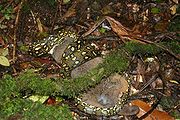
Constriction
Encyclopedia

Snake
Snakes are elongate, legless, carnivorous reptiles of the suborder Serpentes that can be distinguished from legless lizards by their lack of eyelids and external ears. Like all squamates, snakes are ectothermic, amniote vertebrates covered in overlapping scales...
species
Species
In biology, a species is one of the basic units of biological classification and a taxonomic rank. A species is often defined as a group of organisms capable of interbreeding and producing fertile offspring. While in many cases this definition is adequate, more precise or differing measures are...
to kill their prey
Predation
In ecology, predation describes a biological interaction where a predator feeds on its prey . Predators may or may not kill their prey prior to feeding on them, but the act of predation always results in the death of its prey and the eventual absorption of the prey's tissue through consumption...
. Although some species of venomous and mildly-venomous snakes do use constriction to subdue their prey, most snakes which use constriction lack venom. The snake initially strikes at its prey and holds on, pulling the prey into its coils or, in the case of very large prey, pulling itself onto the prey. The snake will then wrap one or two coils around the prey.

Bone
Bones are rigid organs that constitute part of the endoskeleton of vertebrates. They support, and protect the various organs of the body, produce red and white blood cells and store minerals. Bone tissue is a type of dense connective tissue...
s. Traditionally, it has been thought that snakes hold tightly enough to prevent the prey from drawing air into its lungs, resulting in death from asphyxia. However, some prey items seem to die faster than would be possible through asphyxia, so it has also been suggested that the pressure of constriction causes a rise in the pressure in the prey's body cavity greater than the heart can counter, resulting in immediate cardiac arrest
Cardiac arrest
Cardiac arrest, is the cessation of normal circulation of the blood due to failure of the heart to contract effectively...
. This new hypothesis has yet to be confirmed, but data indicates that snakes can exert enough pressure for this mechanism to be plausible. Research into this topic is ongoing. It has been found that the green anaconda (Eunectes murinus) has a constriction strength of 6 kg/cm2, which effectively means a total strength of 4000 kg.
Certain groups of snakes have characteristic patterns of constriction, including the number of coils they use and the orientation of the coils.
Other meanings
Constriction, the opposite of dilation or dilatation, also refers to vasoconstrictionVasoconstriction
Vasoconstriction is the narrowing of the blood vessels resulting from contraction of the muscular wall of the vessels, particularly the large arteries, small arterioles and veins. The process is the opposite of vasodilation, the widening of blood vessels. The process is particularly important in...
, the narrowing of blood vessels caused by vascular smooth muscle
Vascular smooth muscle
Vascular smooth muscle refers to the particular type of smooth muscle found within, and composing the majority of the wall of blood vessels.Vascular smooth muscle contracts or relaxes to both change the volume of blood vessels and the local blood pressure, a mechanism that is responsible for the...
contractions.
Constriction can also refer to the act of binding a victim with rope, either as a method of torture
Torture
Torture is the act of inflicting severe pain as a means of punishment, revenge, forcing information or a confession, or simply as an act of cruelty. Throughout history, torture has often been used as a method of political re-education, interrogation, punishment, and coercion...
or sexual bondage.

